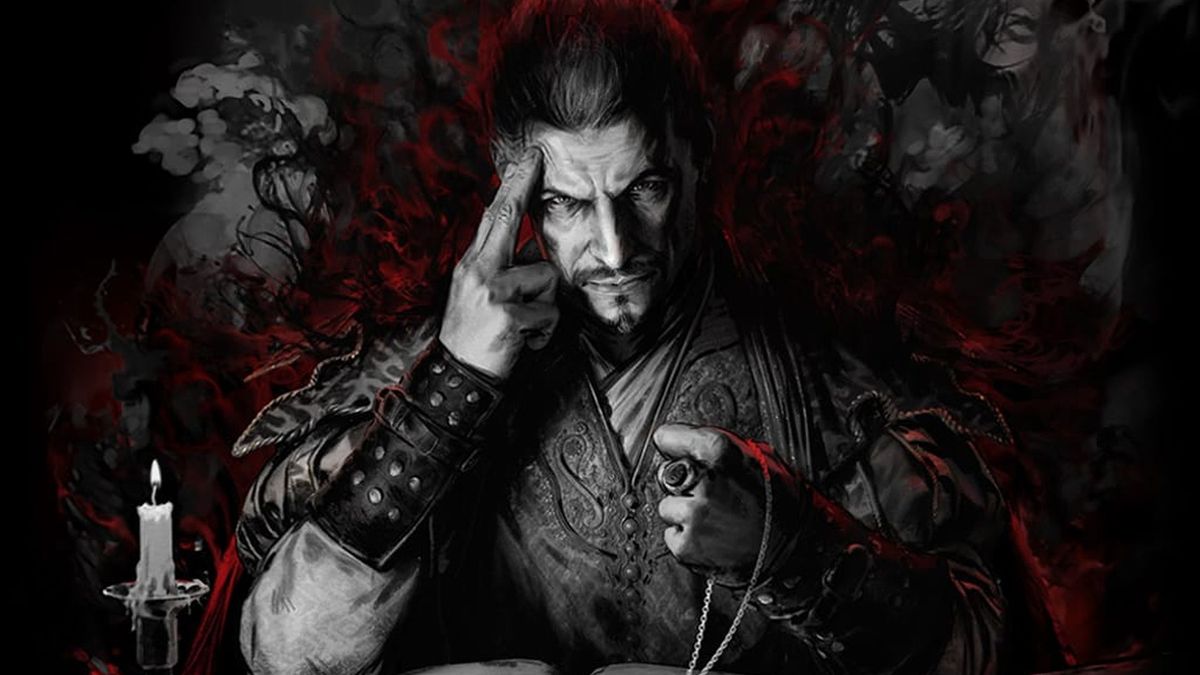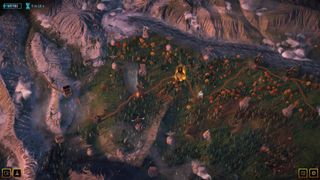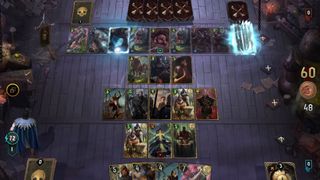
If you're familiar with Gwent, Rogue Mage should be somewhat familiar. Of course, by 'Gwent', I don't mean the game that Geralt and company play in The Witcher 3: Wild Hunt, but the multiplayer version that CD Projekt Red cooked up after the success of their minigame. That standalone game - officially titled 'Gwent: The Witcher Card Game' - kept the characters and the best-of-three format that set the original apart, but elsewhere borrowed more closely from card games like Hearthstone. Players could interact with one another far more closely than in the original game; buffing units, removing cards, messing with enemy formations.
So, Rogue Mage borrows from multiplayer Gwent, but also owes a lot to Thronebreaker: The Witcher Tales – the 2018 narrative spin-off. In Thronebreaker, you took control of the armies of Lyria and Rivia, the twin kingdoms from which Geralt gained his iconic title. As you fought to regain your throne, different enemies – each using different tactics – stood in your way, encouraging a constantly-changing approach to the deck of cards that made up the units in your army. Elsewhere, puzzle-focused encounters flipped the whole system on its head. In one combat, my army looked on helpless as a rockslide sent boulders marching across the entire board, my soldier cards replaced with supply wagons.
Technically the fourth version of Gwent, Rogue Mage cuts the puzzles, but maintains the idea of an evolving deck. While The Witcher 3 Gwent and multiplayer Gwent rely on a finely-tuned collection of cards, Thronebreaker and Rogue Mage encourage many different approaches, your deck adapting from game to game.
A new ExperiGwent
The titular Rogue Mage is Alzur, creator of the first Witchers. In his quest for the ingredients that will create the potion needed to make the monster hunters, Alzur starts at one end of a huge valley. Various paths along the road all lead to a powerful monster at the far end from which the mage hopes to harvest those ingredients, but can also take you through random events, rare treasure troves, and various combat encounters along the way.
In each of those battles, you'll pit your army against the various vagrants that stalk the road, with each combatant using cards to stand in for their respective armies. Where you play those cards matters – certain units buff their neighbors, or have different effects depending on whether you play them in the front or back row of the board. Each unit has a numerical value attributed to it, which can be raised or lowered based on the cards each player uses. Once both sides are out of new cards to play, the side with the highest total score wins. In Gwent: Rogue Mage, if that's you, your journey continues. If you lose, however, Alzur will portal to safety, and you'll have to start again; rewards and narrative that are unlocked at the end of each trip remain available, but you'll return to the beginning of your quest, losing any additions to your deck.

As you progress up the valley, you'll take on progressively-harder foes, each one with their own gimmick. Stumble upon a Necromancer, and you'll gain no advantage from removing enemy cards from the board, as they'll be brought back to life immediately by your opponent's passive trait. In combat against a giant, however, getting certain cards out of play before they can ramp up over the course of a battle is a crucial part of the strategy.
Despite its broad similarities to the other versions of Gwent, Rogue Mage's take on the game is a little disappointing. Its best-of-one format requires a brute-force approach that's at odds with the more delicate back-and-forth of the original games, which thrives on a delicate, tactical subterfuge as players jostle for control after the first round. The varying tactics employed by different NPCs do recover some of that missing strategy element, but with a limited pool of cards in each premade deck, it can be hard to change up your approach.
Sign up to the 12DOVE Newsletter
Weekly digests, tales from the communities you love, and more
Going Rogue
In spite of its changes to Gwent, Rogue Mage isn't a runaway success as a deckbuilding game, either. There are some entertaining combos to be pieced together, and those premade decks are good at forcing you to play to their relative strengths – one leaned into constant, team-wide healing, while another was all about doing as much damage as possible. But the nature of Gwent as a physical card game lends itself more to gradually-increasing power rather than the cyclical nature of genre leaders, like Slay the Spire or Monster Train, where you'll rotate through the same cards multiple times in the course of a battle.
What's more, those 'physical' cards don't lend themselves to arguably the most important aspect of the genre that Rogue Mage is attempting to capture – transparency. In games like Slay the Spire, your opponents' next move is always telegraphed, allowing you to use your turn to block a big attack or capitalize on an opening. A failure might be the result of a bad deck, but it might also be the result of your own bad play – the inability to adapt to or plan for what your opponent was about to throw at you. By contrast, in Gwent: Rogue Mage, that information simply isn't there. Alzur always makes the first move, which means that at the end of a round, your opponent always has one card left to play. I'm never confident that that single card won't lead to the end of a run, one last move that pulls off a game-winning play that I couldn't have prevented, because I couldn't see it coming.

But for all its difficulty capturing the more successful parts of the genre it's trying to be a part of, Gwent: Rogue Mage remains surprisingly compelling. After initially bouncing off its slower pace, I'm starting to rediscover Gwent's intricacies – the impossible choice of which card to play first, the complexity of the web of effects that springs up towards the end of a game – even through this simplified version. That's likely helped by its narrative framework. Alzur's story is set hundreds of years before Geralt's, but while it's a little jarring to see characters from The Witcher 3 show up, CD Projekt Red knows better than anyone how to keep this world feeling legitimate, in spite of its slight anachronism.
I'm desperate to crack Gwent: Rogue Mage, to start to capture the magic of putting together a deck that's my own, working out the delicate interplay between different cards. I've found that magic in the other iterations of Gwent, as well as through innumerable Slay the Sipre runs, but so far it remains hidden in CDPR's latest attempt. The studio's understanding of the world of The Witcher provides an entertaining framework within which to search for that magic, but I'm not sure that the new gameplay format is a better choice than another Thronebreaker might have been.
Rogue Mage might not quite tide you over until it launches, but here's everything we know about The Witcher 4.

I'm GamesRadar's news editor, working with the team to deliver breaking news from across the industry. I started my journalistic career while getting my degree in English Literature at the University of Warwick, where I also worked as Games Editor on the student newspaper, The Boar. Since then, I've run the news sections at PCGamesN and Kotaku UK, and also regularly contributed to PC Gamer. As you might be able to tell, PC is my platform of choice, so you can regularly find me playing League of Legends or Steam's latest indie hit.